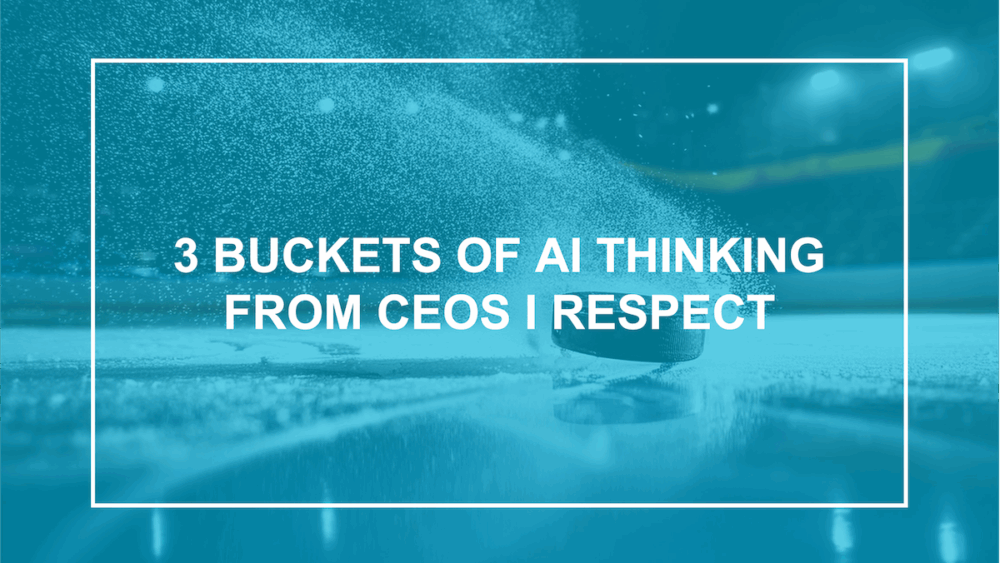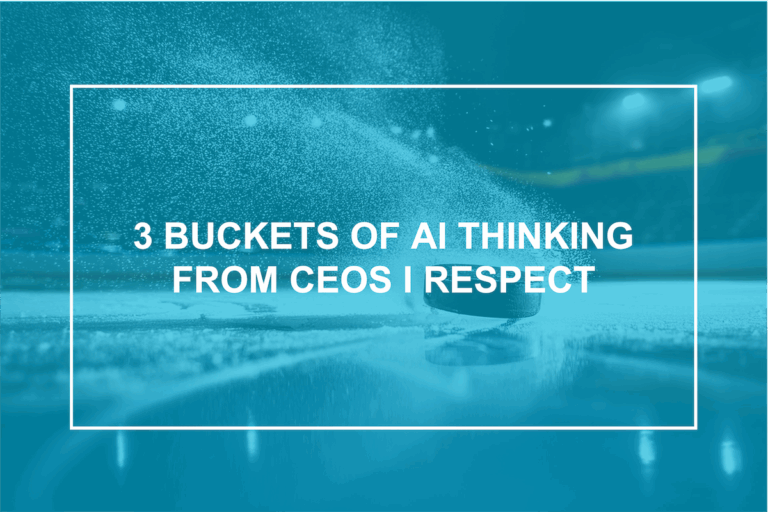3 Buckets of AI Thinking from CEOs I Respect
Another AI blog. You know you wanted it. I mean, here you are…reading it?
This may be a bit different. I, like you, have been talking and listening to discussions about AI itself, the meaning of AI for our economy and our businesses, and fears and optimism about AI for many years.
Something crystallized for me in listening to CEOs and AI-forward company leaders recently that I want to share.
These are the 3 Buckets of AI Thinking, as I’ve seen them play out in leadership. In some ways, I think these have progressed in time over the last 4-5 years, and from my point of view, all but the most forward-leaning, risk-preferring (although there is also risk aversion here) leaders are arriving to or sticking with bucket two right now. The edge-casers are diving headlong into bucket 3, not just as a thought experiment but as a business priority or mandate.
Bucket 1: How can we/must we get more efficient with AI inside our company?
No big secret here. If you’re not in this bucket already, you are surely left behind. Every leader I know has challenged themself to be mindful of how to stay abreast of developments in AI and apply new developments to their team or company in order to be faster, smarter, more efficient. This is the incremental improvement utilization bucket. Again, nothing shiny here. You better be here. The days of objecting on environmental or human interest/future employment grounds seem largely over. From my vantage point as an executive coach and company coach, there was some reluctance from companies to make AI utilization in this bucket a must up until a year ago, but those days are gone.
Bucket 2: How can we make our product better and deliver a better or faster or superior experience to our customers using AI?
Most companies I work with have moved from Bucket 1 to this bucket in the past year. They are beyond driving efficiency and intelligence inside the walls and working to exploit the patent power of AI in all its manifold capabilities through their product to their end users. Agentic AI has sped this up materially. First, it was about saving customer service resources. Now it’s about delivering superior customer service. Fantastic. Great. Hurrah. Keep up the good work.
Bucket 3 (and the reason I wrote this blog): How will our sector change and look totally different such that we will be obsolete if we don’t materially adjust to a new AI-powered world and deliver to our customers either something akin to our value or a new value they don’t yet know they want?

Sometimes having my role is a bummer because in a case like this, I really want to get specific. And I cannot. Suffice it to say that a precious few of my clients and those companies I pay attention to are well past the efficiencies, well past the talk for the sake of pleasing the board, well past the customer benefit phase, and well into envisioning a brand new world that will be here in three years or one year. They are looking at where the puck is headed, and they want to be there to nab it. They are not thinking about the newer players in their space dismissively as young, upstart, harmless ankle-biters. They know that being less entrenched in the way it has been is an asset right now. They are not primarily motivated by fear, but by ambition and an energy to build well in a dynamic landscape.
They have formed a strategy “tiger team.” They have their sharpest people (who are NOT mission-critical in preserving current revenue) moving over to figure out where the revenue will be when everything they’ve known about their sector, ICP, USP, and more is wholly transformed. These conversations are speculative. These conversations themselves are partially powered by AI. These conversations are the most interesting things I’m a part of these days.
If you are not looking at where the ball is going three years out. If you are spending 80% of your time optimizing for quarterly results right now in a sector that will be wholly changed, you are or are about to miss a huge opportunity, and you may also be behind. If the scenarios you are imagining seem like incremental changes, you’re not thinking big or disruptively enough. Reset. Find someone who will tell you the truth. Find five people. Find people who read a ton about history and can see this as a game change and a step change at once. Get busy.
I am eager to hear contrary views on this. Is my structure too simplistic (it may be)? Am I wrong about the percentage of companies that are in Bucket 3? Let’s get into it here.


